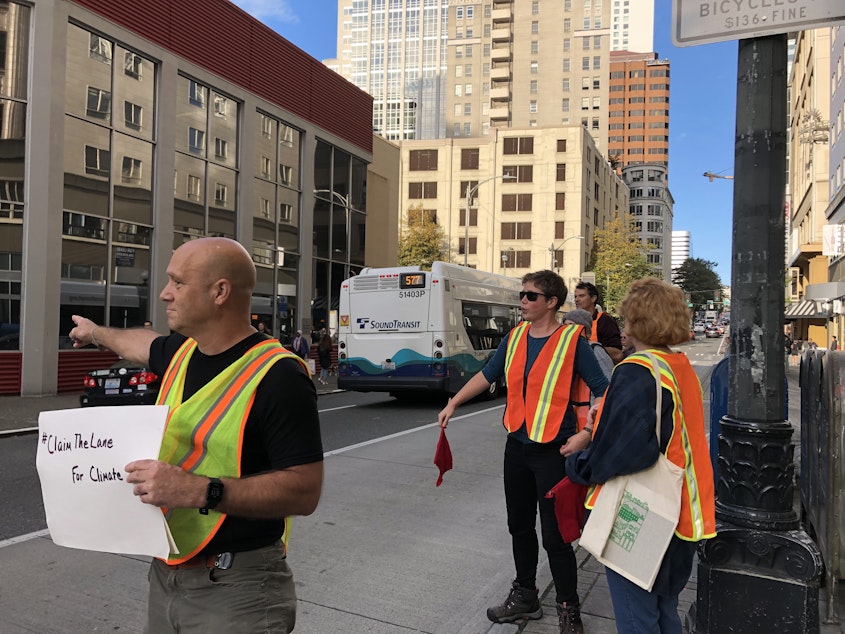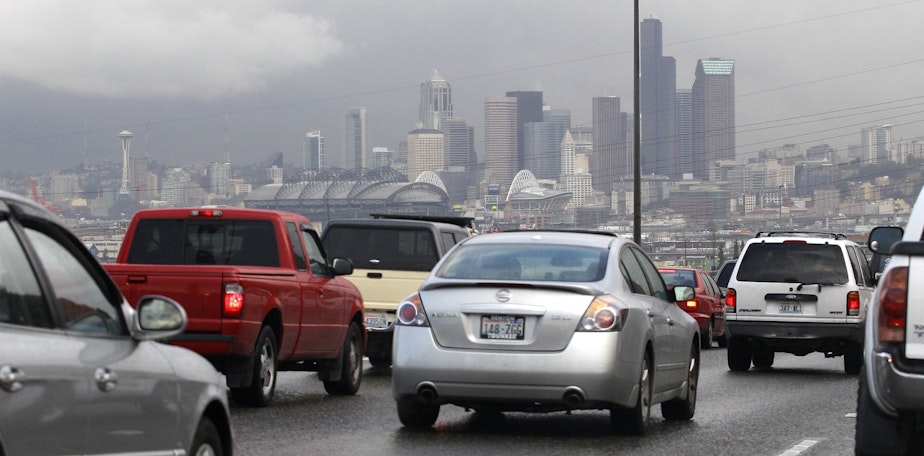West Coast cities lauded for curbing carbon — except Seattle. Here’s why

Seattle Mayor Jenny Durkan spoke Thursday at a climate summit in Copenhagen.
Though Durkan and her predecessors have long proclaimed the Emerald City a national leader in that fight, results have paled beside the rhetoric.
On Wednesday, the hosts of the C40 World Mayors Summit hailed 30 cities around the world, including nine in the United States, for turning a big corner: getting their carbon emissions to decline after decades of growth.
On the West Coast, Los Angeles, Portland, San Francisco, and Vancouver, British Columbia, were all lauded for starting the long climb back down from their peak pollution levels.
Seattle was not among the honored cities.
Sponsored
In a YouTube video that’s been viewed more than 150,000 times over the past few weeks, Durkan says Seattle isn’t waiting to tackle climate change.
“We don’t wait for other people to fix the problem,” Durkan says. “When we saw the climate crisis impacting our economy and our communities, we had to act.”
The ad stars Durkan and was produced by climate-activist billionaire Mike Bloomberg’s organization Beyond Carbon.
When Durkan presented the city’s $6 billion budget at Franklin High School in September, she struck a similar theme.
Sponsored
“With this budget, we will act urgently on climate,” she said. “We must ensure the future of our planet.”
The Durkan administration has pursued various programs aimed at reducing the city’s reliance on fossil fuels, from boosting transit to taxing and phasing out home heating oil.
Since Durkan ran for mayor in 2017, she has promised to lead the nation in fighting climate change. So have Seattle mayors going back to Paul Schell in 2001.
Despite the promises, Seattle’s carbon pollution has stagnated – much like the traffic that is its leading cause.
Sponsored
In downtown Seattle, frustration with buses being stuck behind cars led one commuter to stand in the street this summer and shoo drivers out of a bus-only lane by her bus stop.
Ray Manoppo was waiting for his bus home to Lynnwood when he saw "that lady that went viral."
“We were all frustrated,” he said. “It was 5:30. We’re trying to go home. Everyone kept jumping on this lane. She was so brave. She jumped in the lane and she was like, ‘No, I’m not having this. You guys have got to go.’”
Climate activists started doing the same on some bus lanes, partly to force bad drivers to obey the law, but more to connect the dots between our commutes and our climate.
“Transit is such a key solution to how we can address climate change here in Seattle,” Susan Gleason with the nonprofit Seattle Neighborhood Greenways said while her colleagues were redirecting wayward cars on Olive Way.
Sponsored
Most of the harm Seattle does to the global climate comes from cars and trucks, and most of that, from people driving alone.
“It’s an imperative for the city to find ways to help people move through the city in different ways that aren’t fossil-fuel-based,” Gleason said. “Transit is incredibly effective and efficient at moving a lot of people.”
Transit use has been growing rapidly for years in Seattle, even faster than the city’s population. But that population growth has meant the number of cars and the carbon pollution they spew remain stubbornly high despite the rising popularity of not driving.
Census surveys show more Seattleites walking or taking transit to work in 2018, while the number of people reporting that they drive alone to work showed little change.
Firm numbers on Seattle’s traffic volumes and the resulting carbon output during the Durkan administration won’t be available until the city completes its biannual greenhouse gas inventory with 2018 data some time next year.
Sponsored
“If this were a priority, why is the data so old?” asked Daniel Malarkey, a fellow with the Seattle-based think tank Sightline Institute. “Why isn’t the city reporting quarterly on greenhouse gas emissions? Sure, it’s possible, figure it out. Big corporations report quarterly on their inventories. Figure it out!”
What data is available suggests that Seattle is falling farther behind on its longstanding promise: to slash 58 percent off its carbon emissions over the coming decade.
Under the much more ambitious “green new deal” policy adopted by the Seattle City Council in August, Seattle is supposed to not just halve, but eliminate its carbon emissions in a decade.
According to the Washington State Department of Transportation, King County drivers logged 205 million more miles behind the wheel in 2018 than the year before, a 1.2 percent increase. (The agency declined to provide data at the city level.)
As of March, nonpolluting electric vehicles made up just 1.3 percent of cars registered in Seattle, according to the Electric Power Research Institute.
The mayor’s 2020 budget proposes $47.7 million in bicycle, pedestrian and transit projects, including painting 90 new blocks of red, bus-only lanes, to try to smooth alternatives to driving.
“The mostly small additions of bus priority improvements just don't match the need,” Meg Wade with climate-action group 350 Seattle said. “What we're looking at doing as a city in the next year doesn't even begin to get us there.”
“We know what we need to do to reduce emissions,” said Jessica Finn Coven, who heads the city’s Office of Sustainability and Environment. “We need to give people more transportation options so they're not stuck in their cars. We need to electrify transportation and find cleaner ways to heat our buildings. We know that that's the work we need to do and that we need to do it on a larger scale than we've seen so far.”

In Copenhagen, Mayor Durkan is scheduled to speak on a panel with mayors from Germany, Ghana and the Philippines. The theme: going further, faster, to slash emissions.
But back at home, Seattle has delayed some key efforts to move away from fossil fuels.
• On natural gas: the city council delayed voting on a proposed ban on natural gas in new buildings in September. Durkan supported the delay.
• On bike lanes: Durkan canceled construction of bike lanes in Northeast Seattle in March, which led the city council to pass a law essentially blocking her from doing that again.
• And on one of the biggest-ticket items in the city’s carbon struggle: Durkan’s conceptual proposal for a toll on downtown driving as a way to discourage driving and pay for more climate-friendly transportation has languished.
A year and a half after Durkan introduced the congestion-pricing idea, the city has yet to make a specific proposal or do community outreach around the potentially divisive solution.
Seattle budgeted $1.2 million for studying congestion pricing in 2018 and 2019. City officials said they will have spent $700,000 of that by the end of this year.
A December 2018 Seattle Times poll of 419 Seattle residents found 70 percent opposed a downtown toll.
In August, the city appointed the mayor’s policy director, Edie Gilliss, to launch an outreach effort this fall around congestion pricing. No public meetings are scheduled yet.
Mayor Durkan declined to be interviewed.
“She wants to have a really robust conversation with Seattleites to say what would an equitable framework for congestion pricing in the city look like,” Coven said.
Transit advocate Kelsey Mesher with the Transportation Choices Coalition gave Durkan credit for even raising the idea of something as politically fraught as making people pay for something they’re used to getting for free.
“The mayor has been incredibly positive and outspoken about looking into congestion pricing, which is different from many other cities,” Mesher said. “Politically, it’s challenging everywhere.”

The longer it takes to reduce emissions, the more drastic the cuts must be to avoid what scientists have deemed dangerous amounts of warming in coming decades. A United Nations science panel last year gave the world 12 years to cut emissions almost in half, on a path to eliminating emissions in 32 years, if it hopes to avoid such dangerous warming.
“The science is clear that the deadlines are real, and every week we wait is a week closer to those deadlines,” Seattle City Councilmember Mike O’Brien said.
“It’s a tension I am really personally struggling with,” O’Brien said. “The urgency that the physics demands and the political reality that we need to get workers and frontline communities on the same page, and that takes time.”
O’Brien faces a more personal deadline as well: he is not running for reelection, which means he’s out of a job at the end of the year.
Additional reporting by Ruby de Luna.
This story has been updated.




